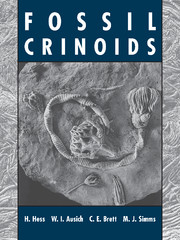Book contents
- Frontmatter
- Contents
- List of Contributors
- Acknowledgements
- Prelude
- Introduction
- GENERAL PART
- ASSEMBLAGES
- 6 Middle Ordovician Trenton Group of New York, USA
- 7 Middle Ordovician of the Lake Simcoe Area of Ontario, Canada
- 8 Upper Ordovician of the Cincinnati, Ohio, Area, USA
- 9 Silurian of Gotland, Sweden
- 10 Middle Silurian Rochester Shale of Western New York, USA, and Southern Ontario, Canada
- 11 Scyphocrinitids from the Silurian–Devonian Boundary of Morocco
- 12 Lower Devonian Manlius/Coeymans Formation of Central New York, USA
- 13 Lower Devonian Hunsrück Slate of Germany
- 14 Middle Devonian Windom Shale of Vincent, New York, USA
- 15 Middle Devonian Arkona Shale of Ontario, Canada, and Silica Shale of Ohio, USA
- 16 Lower Mississippian Hampton Formation at LeGrand, Iowa, USA
- 17 Lower Mississippian Burlington Limestone along the Mississippi River Valley in Iowa, Illinois, and Missouri, USA
- 18 Lower Mississippian Edwardsville Formation at Crawfordsville, Indiana, USA
- 19 Upper Pennsylvanian LaSalle Member, Bond Formation of Central Illinois, USA
- 20 Permian
- 21 Triassic Muschelkalk of Central Europe
- 22 Pentacrinites from the Lower Jurassic of the Dorset Coast of Southern England
- 23 Lower Jurassic Posidonia Shale of Southern Germany
- 24 Middle Jurassic of Southern England
- 25 Middle Jurassic of Northern Switzerland
- 26 Upper Jurassic Solnhofen Plattenkalk of Bavaria, Germany
- 27 Uintacrinus Beds of the Upper Cretaceous Niobrara Formation, Kansas, USA
- 28 Tertiary
- 29 Recent
- Appendix I Geological Time Table with Crinoid Assemblages
- Appendix II Glossary of Rocks
- Bibliography
- General Index
- Taxonomic Index
28 - Tertiary
Published online by Cambridge University Press: 10 November 2010
- Frontmatter
- Contents
- List of Contributors
- Acknowledgements
- Prelude
- Introduction
- GENERAL PART
- ASSEMBLAGES
- 6 Middle Ordovician Trenton Group of New York, USA
- 7 Middle Ordovician of the Lake Simcoe Area of Ontario, Canada
- 8 Upper Ordovician of the Cincinnati, Ohio, Area, USA
- 9 Silurian of Gotland, Sweden
- 10 Middle Silurian Rochester Shale of Western New York, USA, and Southern Ontario, Canada
- 11 Scyphocrinitids from the Silurian–Devonian Boundary of Morocco
- 12 Lower Devonian Manlius/Coeymans Formation of Central New York, USA
- 13 Lower Devonian Hunsrück Slate of Germany
- 14 Middle Devonian Windom Shale of Vincent, New York, USA
- 15 Middle Devonian Arkona Shale of Ontario, Canada, and Silica Shale of Ohio, USA
- 16 Lower Mississippian Hampton Formation at LeGrand, Iowa, USA
- 17 Lower Mississippian Burlington Limestone along the Mississippi River Valley in Iowa, Illinois, and Missouri, USA
- 18 Lower Mississippian Edwardsville Formation at Crawfordsville, Indiana, USA
- 19 Upper Pennsylvanian LaSalle Member, Bond Formation of Central Illinois, USA
- 20 Permian
- 21 Triassic Muschelkalk of Central Europe
- 22 Pentacrinites from the Lower Jurassic of the Dorset Coast of Southern England
- 23 Lower Jurassic Posidonia Shale of Southern Germany
- 24 Middle Jurassic of Southern England
- 25 Middle Jurassic of Northern Switzerland
- 26 Upper Jurassic Solnhofen Plattenkalk of Bavaria, Germany
- 27 Uintacrinus Beds of the Upper Cretaceous Niobrara Formation, Kansas, USA
- 28 Tertiary
- 29 Recent
- Appendix I Geological Time Table with Crinoid Assemblages
- Appendix II Glossary of Rocks
- Bibliography
- General Index
- Taxonomic Index
Summary
THE POOR RECORD OF INTACT TERTIARY CRINOIDS
As a result of the distribution of sea and land during the Tertiary, which was similar to that of today, most marine sediments were deposited in shallow water close to present coastlines. Therefore, there are only a few chances to collect from deposits in which crinoids might be well preserved. The predominance among echinoderms of echinoids, and the extreme rarity of well-preserved crinoids in such sediments, is therefore no surprise. The presence of isocrinids (Metacrinus) in shallow-water sediments of Palaeocene to Oligocene age in New Zealand and the Antarctic Peninsula, as described later in this section, reveal the shift of these stalked crinoids to a deeper environment during the later Palaeogene (Stilwell et al. 1994). It must be assumed that, starting from a low at the Cretaceous–Tertiary boundary, the number of crinoid species has steadily increased during the Tertiary to arrive at the present diversity (see Fig. 3). The poor fossil record of Tertiary crinoids is, therefore, most probably due to non-preservation rather than to a lack of species. In fact, a remarkable number of crinoid remains have been found in the Danian (lowermost Palaeocene), and these include species of Cainocrinus, Calamocrinus, Isselicrinus, Nielsenicrinus and Bourgueticrinus and also comatulids (Rasmussen 1972).
Tertiary crinoids are commonly known only as stem fragments and cups; these remains belong to bourgueticrinids (Bourgueticrinus, Bathycrinus, Conocrinus, Democrinus) and isocrinids (Cainocrinus, Isselicrinus, Nielsenicrinus). In addition, dorsal cups (centrodorsals with radials) of comatulids are found. Complete specimens are very rare. Well-known examples are crowns of Isselicrinus subbasaltiformis from the Lower Eocene of Denmark and England.
- Type
- Chapter
- Information
- Fossil Crinoids , pp. 233 - 236Publisher: Cambridge University PressPrint publication year: 1999
- 11
- Cited by



